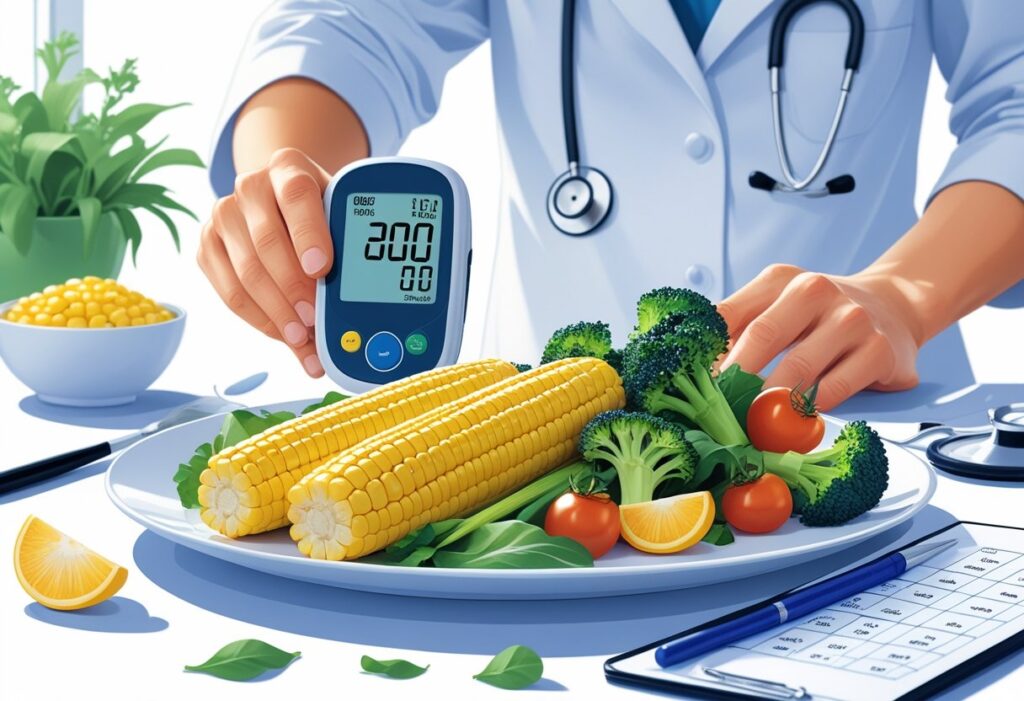Corn can be part of a healthy diet for people with diabetes, but it needs to be eaten in moderation. Corn contains carbohydrates that will raise blood sugar, but it also has fiber and vitamins that provide important nutrients. This balance means corn is not off-limits, but portion control is key.
Because corn is a starchy food, it affects blood sugar differently than non-starchy vegetables. Choosing fresh or minimally processed corn and combining it with protein or healthy fats can help manage its impact. Understanding how corn fits into an overall meal plan is important for maintaining stable blood sugar levels.
People with diabetes should monitor their body’s response to corn and adjust their diet accordingly. With careful planning, corn can be enjoyed without causing large spikes in blood sugar.
Key Takeaways
- Corn contains carbs but also offers fiber and nutrients.
- Portion size and meal combination affect blood sugar response.
- Monitoring individual reactions helps manage diabetes with corn.
Understanding Diabetes and Nutrition

Managing diabetes requires paying close attention to how food affects blood glucose levels. Choosing the right nutrients and balancing carbohydrate intake are essential to keep blood sugar stable and meet the body’s nutritional needs.
The Role of Carbohydrates in Diabetes
Carbohydrates have the biggest impact on blood glucose levels. When carbohydrates are eaten, the body breaks them down into sugar, which enters the bloodstream. People with diabetes must monitor the amount and type of carbohydrates they consume.
Complex carbohydrates, like whole grains and vegetables, digest slower and cause a gradual rise in blood glucose. Simple carbs, found in sugary foods, cause a quick spike. A diet that includes mostly complex carbs can help avoid sudden changes in blood sugar.
Portion size matters too. Even healthy carbs can raise blood glucose if eaten in large amounts. Tracking carbs helps people with diabetes keep their blood sugar within a target range.
Balanced Diet Principles for Diabetes
A balanced diet for diabetes includes a mix of carbohydrates, proteins, and fats. Protein supports muscle health, and healthy fats can improve heart health. A diet low in saturated fat and added sugars helps prevent complications.
Including fiber-rich foods, like vegetables and whole grains, adds bulk and slows sugar absorption. Regular meals spaced evenly during the day help maintain steady blood glucose levels.
Key features of a balanced diet for diabetes:
- Moderate carbohydrate intake
- Plenty of fiber from vegetables and whole grains
- Lean protein sources like fish, poultry, or beans
- Healthy fats from nuts, seeds, and olive oil
- Limited processed foods and sugars
Nutritional Needs for Blood Glucose Control
Controlling blood glucose requires stable, steady energy from food. Nutritional needs focus on managing carbohydrate quality and timing meals well. Fiber helps slow sugar absorption, while protein and fat slow digestion and improve blood sugar control.
Vitamins and minerals like magnesium and chromium also support glucose metabolism. Staying hydrated and avoiding excess sodium helps maintain overall health.
Daily meal plans should balance nutrient intake to prevent blood glucose highs and lows. Regular monitoring allows adjustments to diet based on blood sugar reactions.
For more details on how corn fits into this balance, see how it is a good source of fiber and nutrients but should be consumed in moderation for effective blood glucose control. Corn and diabetes nutrition information can be found here.
Corn: Nutritional Profile and Health Impact

Corn contains important nutrients like vitamins, minerals, fiber, and antioxidants. Its carbohydrate content affects blood sugar levels, so understanding these details helps manage diet choices safely.
Nutritional Value of Corn
Corn is low in fat and calories but rich in vitamins such as vitamin C, several B vitamins, and minerals like magnesium and potassium. It provides energy mainly through carbohydrates and offers a moderate amount of protein.
Some types of corn also contain antioxidants, which support overall health. The mix of nutrients makes corn a balanced food option when consumed in proper amounts. It is important to note that it is often classified as a starchy vegetable or grain because of its nutrient profile and carbohydrate content.
Carbohydrate Content in Corn
Corn has a significant amount of carbohydrates, primarily in the form of starch. This can cause a rise in blood sugar after eating. The glycemic index (GI) of corn varies but is generally moderate.
Portion size matters because eating large amounts of corn can spike blood sugar in people with diabetes. Monitoring and controlling intake can help maintain better blood sugar levels. Boiled or fresh corn tends to have a lower GI than processed corn products.
Fiber and Antioxidants in Corn
Corn is a good source of dietary fiber, which helps slow digestion and blood sugar absorption. This can improve blood sugar control and support digestive health.
Additionally, corn contains antioxidants such as carotenoids, which can reduce oxidative stress. These antioxidants may help lower inflammation and support diabetes management. Fiber and antioxidants together make corn more than just a carbohydrate source; they contribute to its health benefits when eaten in appropriate portions.
For more detailed information about the nutritional benefits of corn, see Healthline’s article on Diabetes and Corn.
Is Corn Healthy for People with Diabetes?

Corn contains carbohydrates that affect blood sugar but also offers fiber and nutrients that can support a balanced diet. Managing portion size and choosing the right type of corn help control blood glucose levels for people with diabetes or prediabetes.
Effect of Corn on Blood Sugar
Corn has carbohydrates that raise blood sugar, so it impacts blood glucose like other starchy foods. However, corn’s glycemic index is relatively low, which means it causes a slower rise in blood sugar compared to high-GI foods. The fiber in corn helps slow digestion and can improve blood sugar control.
People with diabetes should count the carbs in corn as part of their meal planning. For example, a half-cup serving of cooked corn contains about 15 grams of carbohydrates. This amount fits well in a carb-controlled diet if balanced with protein and healthy fats.
Choosing the Right Type and Portion of Corn
Fresh corn and popcorn are better choices for people with diabetes than processed corn products like corn syrup or fried corn snacks. Boiled or grilled corn without added butter or salt keeps fat and sodium low, supporting heart health, which is important for diabetics.
Portion size matters. Eating one small ear of corn or a half-cup serving helps manage carbohydrate intake. Tracking serving sizes and counting carbs make it easier to avoid blood sugar spikes. This is especially important for those with prediabetes aiming to prevent full diabetes. For more details, see healthline’s guide on corn and diabetes.
Corn Compared to Other Food Groups for Diabetes

Corn has unique traits compared to other food groups like grains, vegetables, fruits, and legumes. Its carbohydrate content and fiber level place it somewhere between starchy vegetables and grains. Understanding these differences helps people with diabetes make better food choices.
Corn vs. Other Grains
Corn is a grain but differs from common grains like brown rice, white rice, whole wheat, oats, and refined grains. Corn has a glycemic index (GI) around 52, which is lower than white rice and refined grains. This means it raises blood sugar more slowly.
Whole grains like brown rice and whole wheat often provide more fiber and nutrients than corn does. However, corn contains fiber and vitamins too, making it better than some refined grains. People with diabetes may choose corn over high-GI grains for steadier blood sugar control.
Corn and Starchy vs. Non-Starchy Vegetables
Corn is classified as a starchy vegetable because of its higher carbohydrate content compared to non-starchy vegetables like spinach or broccoli. Non-starchy vegetables have fewer carbs and have little effect on blood sugar.
Compared to other starchy veggies like potatoes and peas, corn has a moderate glycemic impact. It provides fiber and nutrients but will raise blood sugar more than non-starchy vegetables. Pairing corn with protein and healthy fats can reduce its blood sugar effect.
Corn Compared to Fruits and Legumes
Fruits generally contain natural sugars that affect blood sugar, but many have fiber that slows sugar absorption. Corn has fewer natural sugars but more starch than most fruits. Its effect on blood sugar can be similar to some fruits with moderate GI.
Legumes like beans and lentils have a low GI and high fiber and protein. They are often better for blood sugar control than corn. However, corn offers certain vitamins and fiber that legumes do not. Adding variety with both legumes and corn can benefit a diabetes-friendly diet.
For more details on corn and blood sugar, see Diabetes and Corn: Can Diabetics Eat Corn?.
Integrating Corn into a Diabetes-Friendly Meal Plan
Corn can be part of a balanced meal plan for people with diabetes when used thoughtfully. Controlling portion sizes and pairing corn with other nutrient-rich foods helps manage blood sugar levels effectively.
Meal Planning Strategies with Corn
When adding corn to meals, portion control is crucial because corn contains carbohydrates that impact blood sugar. A typical serving size is about half a cup cooked.
Using corn as a side or ingredient in dishes with low glycemic index foods helps balance blood sugar spikes. It is best to avoid processed corn products like corn chips or high-sodium canned corn.
Incorporating corn alongside non-starchy vegetables and whole grains adds fiber, which slows digestion. Planning meals with a balanced mix of macronutrients supports consistent energy and blood sugar control.
Combining Corn with Lean Proteins and Healthy Fats
Pairing corn with lean proteins such as chicken, fish, or beans improves blood sugar management. Proteins help slow carbohydrate absorption and increase fullness.
Adding healthy fats like avocado, olive oil, or nuts complements corn in meals. These fats support heart health, which is important for people with diabetes.
Examples of balanced meals include corn salad with grilled chicken and olive oil dressing or a bowl with corn, black beans, and avocado. These combinations provide fiber, protein, and healthy fats while keeping carbohydrates steady.
For more guidance, see meal planning ideas that include corn for diabetes at Diabetes Care Community.




Pingback: Diabetes Prediction Using Machine Learning: Models, Data, and Accuracy - Pharma Heals
Pingback: Overnight Oats for Diabetes: How This Simple Breakfast Can Help Stabilize Your Blood Sugar Levels - Pharma Heals